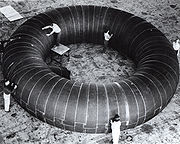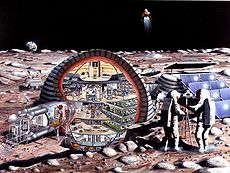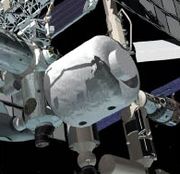
Inflatable space habitat
Encyclopedia


The first serious design and manufacture of an inflatable space habitat was in 1961 with a space station
Space station
A space station is a spacecraft capable of supporting a crew which is designed to remain in space for an extended period of time, and to which other spacecraft can dock. A space station is distinguished from other spacecraft used for human spaceflight by its lack of major propulsion or landing...
design produced by Goodyear
Goodyear Tire and Rubber Company
The Goodyear Tire & Rubber Company was founded in 1898 by Frank Seiberling. Goodyear manufactures tires for automobiles, commercial trucks, light trucks, SUVs, race cars, airplanes, farm equipment and heavy earth-mover machinery....
(although this design was never flown). A proposal released in 1989 by Johnson Space Center's
Lyndon B. Johnson Space Center
The Lyndon B. Johnson Space Center is the National Aeronautics and Space Administration's center for human spaceflight training, research and flight control. The center consists of a complex of 100 buildings constructed on 1,620 acres in Houston, Texas, USA...
Man Systems Division outlined a 16 metres (52.5 ft) diameter spherical habitat lunar outpost which was partially buried in the lunar
Moon
The Moon is Earth's only known natural satellite,There are a number of near-Earth asteroids including 3753 Cruithne that are co-orbital with Earth: their orbits bring them close to Earth for periods of time but then alter in the long term . These are quasi-satellites and not true moons. For more...
surface.
An inflatable module called TransHab
Transhab
TransHab was a concept pursued by NASA to develop the technology for expandable habitats inflated by air in space. Specifically, TransHab was intended as a replacement for the already existing rigid International Space Station crew Habitation Module. When deflated, inflatable modules provide an...
(a portmanteau of Trans Habitation) was proposed for the International Space Station
International Space Station
The International Space Station is a habitable, artificial satellite in low Earth orbit. The ISS follows the Salyut, Almaz, Cosmos, Skylab, and Mir space stations, as the 11th space station launched, not including the Genesis I and II prototypes...
, and later the private company Bigelow Aerospace
Bigelow Aerospace
Bigelow Aerospace is a North Las Vegas, Nevada space technology startup company that is pioneering work on expandable space station modules. Bigelow Aerospace was founded by Robert Bigelow in 1998...
revived the design for use in a number of potential civil and commercial applications.
Construction
The construction of an inflatable space habitat is determined by its design objectives. However common elements include interwoven layers of KevlarKevlar
Kevlar is the registered trademark for a para-aramid synthetic fiber, related to other aramids such as Nomex and Technora. Developed at DuPont in 1965, this high strength material was first commercially used in the early 1970s as a replacement for steel in racing tires...
and mylar around a flexible air bladder which is used to retain an atmosphere
Atmosphere
An atmosphere is a layer of gases that may surround a material body of sufficient mass, and that is held in place by the gravity of the body. An atmosphere may be retained for a longer duration, if the gravity is high and the atmosphere's temperature is low...
. The shape of the module is maintained by the pressure difference between the internal atmosphere and the outside vacuum
Vacuum
In everyday usage, vacuum is a volume of space that is essentially empty of matter, such that its gaseous pressure is much less than atmospheric pressure. The word comes from the Latin term for "empty". A perfect vacuum would be one with no particles in it at all, which is impossible to achieve in...
. The inflatable Bigelow Aerospace
Bigelow Aerospace
Bigelow Aerospace is a North Las Vegas, Nevada space technology startup company that is pioneering work on expandable space station modules. Bigelow Aerospace was founded by Robert Bigelow in 1998...
modules have an internal core which provides structural support during its launch into orbit
Orbit
In physics, an orbit is the gravitationally curved path of an object around a point in space, for example the orbit of a planet around the center of a star system, such as the Solar System...
.

Ongoing research
Currently the main areas of research are being undertaken by Bigelow AerospaceBigelow Aerospace
Bigelow Aerospace is a North Las Vegas, Nevada space technology startup company that is pioneering work on expandable space station modules. Bigelow Aerospace was founded by Robert Bigelow in 1998...
and NASA
NASA
The National Aeronautics and Space Administration is the agency of the United States government that is responsible for the nation's civilian space program and for aeronautics and aerospace research...
. NASA is currently studying inflatable lunar bases with the planetary surface habitat and airlock unit which is in an early prototype phase, and has conceptual proposals for utilizing expandable-technology space structures in cislunar and interplanetary crewed exploration spacecraft.
Bigelow Commercial Space Station
The Bigelow Next-Generation Commercial Space Station, composed of two types of expandable space habitat modules, was announced in mid-2010.The initial build-out of the station is expected in 2014/2015, and will consist of two Sundancer
Sundancer
Sundancer is the proposed third prototype space habitat to be launched by Bigelow Aerospace and the first human-rated expandable module based on TransHab technology acquired from NASA...
modules and one BA-330 module.
Bigelow has publicly shown space station design configurations with up to nine BA-300 modules containing 100000 cu ft (2,831.7 m³) of habitable space
Sundancer is currently under construction, and the BA-330 is in final design with construction getting underway in 2011.
Bigelow began to publicly refer to the initial configuration—two Sundancer
Sundancer
Sundancer is the proposed third prototype space habitat to be launched by Bigelow Aerospace and the first human-rated expandable module based on TransHab technology acquired from NASA...
modules and one BA-330 module—as "Space Complex Alpha" in October 2010.
Bigelow recently announced that it has agreements with six sovereign state
Sovereign state
A sovereign state, or simply, state, is a state with a defined territory on which it exercises internal and external sovereignty, a permanent population, a government, and the capacity to enter into relations with other sovereign states. It is also normally understood to be a state which is neither...
s to utilize on-orbit facilities of the commercial space station: United Kingdom
United Kingdom
The United Kingdom of Great Britain and Northern IrelandIn the United Kingdom and Dependencies, other languages have been officially recognised as legitimate autochthonous languages under the European Charter for Regional or Minority Languages...
, Netherlands
Netherlands
The Netherlands is a constituent country of the Kingdom of the Netherlands, located mainly in North-West Europe and with several islands in the Caribbean. Mainland Netherlands borders the North Sea to the north and west, Belgium to the south, and Germany to the east, and shares maritime borders...
, Australia
Australia
Australia , officially the Commonwealth of Australia, is a country in the Southern Hemisphere comprising the mainland of the Australian continent, the island of Tasmania, and numerous smaller islands in the Indian and Pacific Oceans. It is the world's sixth-largest country by total area...
, Singapore
Singapore
Singapore , officially the Republic of Singapore, is a Southeast Asian city-state off the southern tip of the Malay Peninsula, north of the equator. An island country made up of 63 islands, it is separated from Malaysia by the Straits of Johor to its north and from Indonesia's Riau Islands by the...
, Japan
Japan
Japan is an island nation in East Asia. Located in the Pacific Ocean, it lies to the east of the Sea of Japan, China, North Korea, South Korea and Russia, stretching from the Sea of Okhotsk in the north to the East China Sea and Taiwan in the south...
and Sweden
Sweden
Sweden , officially the Kingdom of Sweden , is a Nordic country on the Scandinavian Peninsula in Northern Europe. Sweden borders with Norway and Finland and is connected to Denmark by a bridge-tunnel across the Öresund....
.
NASA Multi-Mission Space Exploration Vehicle
In early 2011, NASA put forward a conceptual proposal for a for a long-duration crewed space transport vehicle which includes an artificial gravityArtificial gravity
Artificial gravity is the varying of apparent gravity via artificial means, particularly in space, but also on the Earth...
space habitat
Space habitat
A space habitat is a space station intended as a permanent settlement rather than as a simple waystation or other specialized facility...
intended to promote crew-health for a crew of up to six persons on missions of up to two years duration. Called the Multi-Mission Space Exploration Vehicle (MMSEV), the partial-g torus-ring
Torus
In geometry, a torus is a surface of revolution generated by revolving a circle in three dimensional space about an axis coplanar with the circle...
centrifuge
Centrifuge
A centrifuge is a piece of equipment, generally driven by an electric motor , that puts an object in rotation around a fixed axis, applying a force perpendicular to the axis...
would utilize both standard metal-frame and inflatable spacecraft structures and would provide 0.11 to .
Related to MMSEV is the ISS
ISS
The ISS is the International Space Station.ISS may also refer to:* I See Stars, an American electronic rock band* ISS A/S, a Danish service company* Idea Star Singer, a Malayalam music reality show by Asianet TV...
Centrifuge Demo, proposed in 2011 as a demonstration project preparatory to the final design of the larger torus centrifuge space habitat for the Multi-Mission Space Exploration Vehicle. The structure would have an outside diameter of 30 feet (9.1 m) with a 30 inches (76.2 cm) ring interior cross-section diameter and would provide 0.08 to partial gravity. This test and evaluation centrifuge would have the capability to become a sleep module for ISS crew.
Advantages
- Because the diameter of the habitat is not strictly constrained by the diameter of the launch vehicle, inflatables can have a greater volume of living space for a given mass.
- (some designs) higher resistance to space debrisSpace debrisSpace debris, also known as orbital debris, space junk, and space waste, is the collection of objects in orbit around Earth that were created by humans but no longer serve any useful purpose. These objects consist of everything from spent rocket stages and defunct satellites to erosion, explosion...
. For example, the BA 330 provides ballistic protection superior to traditional aluminum shell designs. - (some designs) provide higher levels of shielding against radiation. For example, the BA 330 provides radiation protection equivalent to or better than the International Space StationInternational Space StationThe International Space Station is a habitable, artificial satellite in low Earth orbit. The ISS follows the Salyut, Almaz, Cosmos, Skylab, and Mir space stations, as the 11th space station launched, not including the Genesis I and II prototypes...
, "and substantially reduces the dangerous impact of secondary radiation."
Flight experience
Currently the only designs that have flown in space have been the Genesis I and Genesis IIGenesis II
Genesis II is a 1973 American TV film created and produced by Gene Roddenberry and directed by John Llewellyn Moxey.It opens with the line, "My name is Dylan Hunt...
modules from Bigelow Aerospace
Bigelow Aerospace
Bigelow Aerospace is a North Las Vegas, Nevada space technology startup company that is pioneering work on expandable space station modules. Bigelow Aerospace was founded by Robert Bigelow in 1998...
.
See also
- Colonization of the MoonColonization of the MoonThe colonization of the Moon is the proposed establishment of permanent human communities on the Moon. Advocates of space exploration have seen settlement of the Moon as a logical step in the expansion of humanity beyond the Earth. Recent indication that water might be present in noteworthy...
:Category:Human habitats
- Human outpostHuman outpostHuman outposts are artificially-created, controlled human habitats located in environments inhospitable for humans, such as on the ocean floor, in space or on another planet....
(artificially created controlled human habitat)

